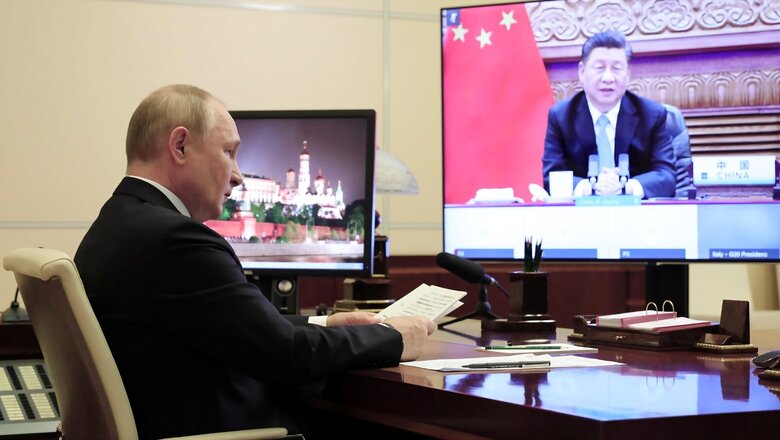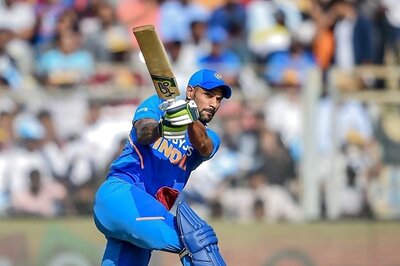
views
The continuing Russian invasion of Ukraine and bombing of several cities have provided a strategic opportunity for China, but also several challenges to its foreign and security challenges — typically representing the meaning for its word weiji.
First, the opportunities for China. After the Soviet disintegration in 1991, the strategic target of the Western countries led by the United States gradually focused on China, despite their thriving economic and technological cooperation. Western attention on counter-terrorism in the wake of 9/11 events provided respite for China.
However, in the last decade, China’s assertiveness in the neighbourhood and beyond has led the US to configure Beijing as a “pacing challenge” as the US Defence Secretary Lloyd Ashton stated. Russian invasion now tends to bring back the US-Russia confrontation to the forefront in the Trans-Atlantic region, providing China once again a strategic opportunity to expand its power in the Indo-Pacific. China’s adventurism in the region now knows no bounds, except for the resistance posed by regional powers like Japan, Australia, Vietnam, India and others.
A second opportunity for China of Russian actions on Georgia, Crimea and Donbass region is the chance provided for attacks on Taiwan or its neighbours on “legitimate security interests” although no treaty or law exists on China’s claims. At the 19th communist party congress in 2017, China unveiled its “six nos” policy and at its 100th anniversary in July last year threatened to “break heads” on the Taiwan issue. As a result, last year saw nearly 4,000 air force sorties flown by China in Taiwan Straits, including in the last two days. Potential Taiwan invasion by China is a major outcome of the Ukrainian developments, except that Taiwan’s military could successfully withstand such pressures.
Also, as an armed stalemate prevails in the India-China border areas after the deadly clash of 15 June 2020 at Galwan that left 20 Indian soldiers killed, Beijing may be tempted to create another military adventure on the Indian border given the Indian stout standing up so far. The five-point proposals of the Moscow meeting in September 2020, nor the 10 February 2021 defence ministries agreement nor even the 14 corps commanders’ meetings have not led to “disengagement and de-escalation” process at all friction points on the borders and China is exasperated with Indian effective resistance so far.
However, challenges galore for Beijing. To wade off Western unilateral policies and regime change, China and Russia have for the past two decades pushed through a multi-polarity debate and criticised the US actions in Iraq and Afghanistan. Ironically, Russian actions in Ukraine — defended by China’s foreign minister Wang Yi as “legitimate security concerns” threaten to upset the apple cart and take the sting away from any future western actions on China.
China’s policy has also exhibited inconsistencies and contradictions. In 2014 when Russia occupied Crimea, China abstained from the United Nations Security Council resolution, while it supported Russian position on 31 January just before the Putin-Xi meeting in Beijing. However, at the 25 February discussions, China abstained from the UNSC resolution that condemned Russian “aggression” on Ukraine.
Second, Russian military invasion comes at a wrong time for China even though both are said to have an understanding on the timing of such an invasion at the recently completed Beijing Winter Olympics. The communist party in China is scheduled to hold its 20th congress late this year and political factional struggles are intensifying. Russia, which helped form the communist party in 1921, has a lot of political leverage in China and the Ukrainian developments are expected to play out in the domestic political struggles. Already several factional leaders in China are questioning the Russian actions. Despite the clampdown on any negative coverage of Russia in China’s media, political dissonance in China is rising.
Thirdly, the new Cold War between the US and Russia and the sanctioned announced in the last few days are threatening free flow of goods and services, investments, banking, insurance and shipping on which China is heavily dependent for its prosperity. President Xi Jinping said at Davos meetings that he staked claims to the leadership of the globalisation process.
Even though China had announced a “dual circulation” strategy of lessening its dependence on exports, this process may take a longer duration and hence the Ukrainian fallout is problematic. The US had also sanctioned several Chinese entities following the tariff wars since the Trump Administration. Associating with Russia could further increase costs for China as the sanction regime intensifies.
Fourth, rising China is heavily dependent on energy imports. With sanctions and rise in energy prices from $94 per barrel before the Russian invasion to over $100 per barrel, China’s energy imports face sustainable and affordable supply disruptions in the near future. China imported 513 million tonnes of crude oil last year, while expected “medium high” growth rate this year require more imports. Russia is now the 2nd largest energy supplier to China with a 44 per cent increase in energy exports (about $45 billion worth) last year, but the latter is heavily dependent on the rest of the world to fuel its rise. Russian energy contribution in China’s imports is only about 15 per cent. Clearly, Russia-China quid pro quo has limitations.
Fifth, while China has a “strategic cooperation” with Russia and it is termed higher than a military alliance by President Putin, bilateral relations show less depth with bilateral trade only $140 billion last year, compared to its nearly $3 trillion with the US allies.
Even though the joint statement of Russia and China on 4 February just before the Beijing Winter Olympics had stated “no limits” to their cooperation, China also has good relations with Ukraine. China’s trade with Ukraine is about $20 billion and investments of over $200 million, specifically in food industry, besides cooperation in defence industries. China’s Belt and Road Initiative project also passes through Ukraine, besides China’s companies like Huawei, COFCO, China Harbor and others denting into the local market. More significantly, China and Ukraine have an “extended’ nuclear deterrence agreement with visiting president Viktor Yanukovich in 2013 and with unverified reports of Russian tactical nuclear deployments in Ukraine, the nuclear factor becomes more complicated for Beijing.
Finally, China’s flip-flop on the UN Charter of “non-interference” policy, “protection of sovereignty and territorial integrity”, supporting “legitimate security interests” of nations were tested with Russian bombing of civilians, targeting the elected Ukrainian President Volodymyr Zelenskyy and support to separatist leaders of Donetsk and Luhansk regions.
By supporting these Russian actions, China is entering into a quagmire with its campaign in Xinjiang, Tibet and Inner Mongolian “separatist” movements. It would be hard for China to convince the international community about the fallout of the Russian actions on its own campaign in these regions and its inconsistencies exploited by others. This is also aggravated with the Western sanctions on the human rights issue in Xinjiang, Tibet Policy Support Act of the US and other measures.
The author is a professor in Chinese Studies at JNU. The views expressed in this article are those of the author and do not represent the stand of this publication.
Read all the Latest Opinion News and Breaking News here

















Comments
0 comment